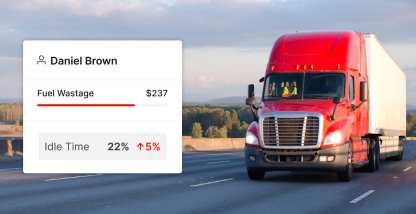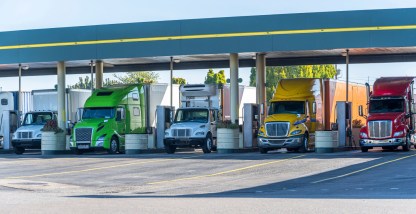Choosing a fleet management solution is a decision that will impact your business for years to come. The right solution can simplify operations, reduce costs, and accelerate growth. The wrong solution can cause unnecessary headaches, leave your business at risk, and restrict growth.
In this article, we’ll walk through the main factors to consider when choosing fleet management software, including:
- Key fleet management solution features
- Installation
- User experience
- Support and reliability
- Data vs insights
- Integrations
Key fleet management solution features
Let’s start by breaking down the key fleet management features you should be aware of:
Compliance
Determining your compliance needs is an important place to start when evaluating fleet management solutions. Specifically, do you need to:
Comply with the FMCSA’s ELD mandate?
Choose an ELD solution that is self-certified with the FMCSA, reliable, easy for drivers to use, and offers Bluetooth and USB connectivity (to avoid the risk of cellular no coverage areas).
Complete pre and post-trip inspection reports?
Choose a solution with easy-to-use and customizable vehicle inspection forms.
File International Fuel Tax Agreement reports?
Choose a solution that tracks miles by jurisdiction, allows your drivers to upload fuel receipts, and integrates with your fuel card provider.
If you don’t need compliance today, consider whether you will need to in the future as your business grows. Choosing a solution that doesn’t offer compliance, or offers unreliable compliance, can cause operational headaches down the road.
GPS tracking
While it sounds pretty straight-forward, GPS tracking functionality can vary widely. Here are a few questions to determine what you should be looking for:
Do you have trailers, equipment, or other high-value assets?
Choose a solution that offers asset tracking as well as vehicle tracking. Being able to track everything from a single dashboard will save your team time.
Do you frequently call or email customers with driver ETA updates?
Choose a solution that can automatically send ETA notifications.
Do you need to know how long drivers or assets spend at a job site? Or when they arrive and leave a facility?
Choose a solution that includes geofence reporting and alerts.
Beyond features, there are a few important details that determine how fleet management providers deliver on GPS tracking. Look for a solution that:
- Transmits GPS locations every 30 seconds, or better yet, based on changes in speed and bearing
- Includes high-speed WiFi at no additional cost to save on data expenses
- Provides historical GPS reporting for any point in the past. This is very useful for preventing after hour vehicle misuse and handling
Safety
If you run a vehicle-based business, safety is top of mind. Here are the key safety features a fleet management solution should offer to reduce risk and help make your fleet safer:
- Real-time alerts for critical events such as harsh braking, hard corners, and speeding
- Automatic categorization of the cause of the critical event, such as tailgating or improper lane changes
- Customizable driver scorecards to easily identify your most dangerous drivers
- A “coaching workflow” that allows you to track and document coaching efforts
- Built-in dash cams that automatically capture footage of critical events
- An ability to view dash cam footage in real-time and request video from the past
Efficiency and performance
A fleet management solution should also help you reduce costs and improve efficiency by providing:
- Idle time reports to identify excessive vehicle idling and reduce fuel usage
- Asset utilization reports to identify assets that aren’t being used to their full potential
- Vehicle diagnostic and fault code reports to prevent breakdowns and proactively plan maintenance
Driver communication and dispatch
Lastly, a fleet management solution should help your team streamline and centralized communication with:
- Instant messaging to drivers with read receipts
- Broadcast messages to all drivers or specific groups
- The ability to send and store documents such as proof of delivery and receipts
- Driver workflow/dispatch integration with customizable forms
Installation
While there are a number of installation methods, here are the two main ones:
- Hardwired. The telematics device is wired directly to the vehicle’s onboard computer. This often requires drilling holes in your vehicle and a few mechanic hours.
- Plug-and-play. The telematics device plugs into the vehicle’s diagnostic port. This generally takes a few minutes and doesn’t require a mechanic.
For some fleets, a hardwired installation process might not be too much of an issue. But, if you frequently lease or rent vehicles or plan on adding or upgrading vehicles in the future, this could be an unexpected ongoing expense and unnecessary complication.
Another consideration is that technology occasionally malfunctions. Even if the device is covered with a warranty, any vehicle downtime or mechanic costs will be paid by you.
A “plug-and-play” solution will likely save you a significant amount of money and operational headaches down the road.
User experience
Your team’s ability to use your fleet management solution will be one of the main factors that will determine your ROI. Choose a solution that is intuitive with a modern interface. Also, map out some common daily tasks your team will need to complete and walk through each task during your evaluation process.
You’ll likely find that solutions vary widely in this area. In fact, Motive was found to be 50% easier to use in a recent study.
However, don’t just review the user experience from the back office perspective. The driver app experience is essential to the successful adoption of a fleet management solution. Be sure to check the app store reviews to hear what real drivers have to say.
Support and reliability
You need more than a product—you need a partner. When evaluating fleet management solutions, you need to go beyond the promises of the sales rep and verify that the company is following through on its promises to customers.
The easiest way to do this is to check online reviews. Some of the leading review sites for fleet management are Capterra, G2Crowd, and GetApp.
Additionally, customer support is an important factor to consider:
- Do they offer 24/7 support? Your business doesn’t operate on bankers hours and neither should your fleet management solution’s customer service.
- Can I reach a representative quickly? Be sure to call in yourself and verify you can actually reach a person. Long wait times will be a drain on your team’s productivity.
- What resources are available to ensure your success? Fleet management is a big investment. Be sure to ask how they will help you successfully implement and utilize their software.
Data vs. insights
One of the big benefits of a fleet management solution is the data it provides on your operations. This data has the potential to reduce costs, prevent collisions, and so much more. But, there’s a catch.
It’s not the data itself that provides an ROI. It’s the insights that can be gathered from it. Many solutions simply present the data in a spreadsheet-like format. Unless you have a team of data scientists in-house, it could be challenging to find problems, trends, and opportunities.
Look for a solution that makes it easy to identify what is out of the ordinary and where your opportunities for optimization are.
Integrations
A fleet management solution should be a bridge—not an island. Being able to connect to other business systems can be a key driver of operational efficiency and can help unlock the full value of your data.
Look for a provider with a number of pre-built integrations. Additionally, look for a fleet management system with an open API. An open API means that if an integration doesn’t exist, anyone can create it with the help of a developer.
Even if you don’t have an immediate need to integrate, choosing a solution with the infrastructure in place to do so will open up opportunities in the future.
Making the right choice for your business
A fleet management solution is a significant investment, and there are many providers in the market. Choosing a solution can feel overwhelming at first, but by evaluating each option based on the criteria in this article, you’ll be well on your way to making an intelligent choice for your business.
Ready to start evaluating? Take a look at the Motive fleet management solution or create your free account today.









